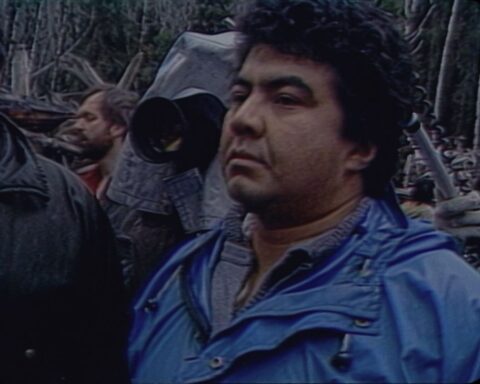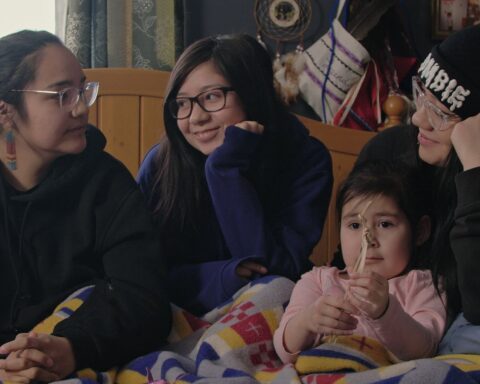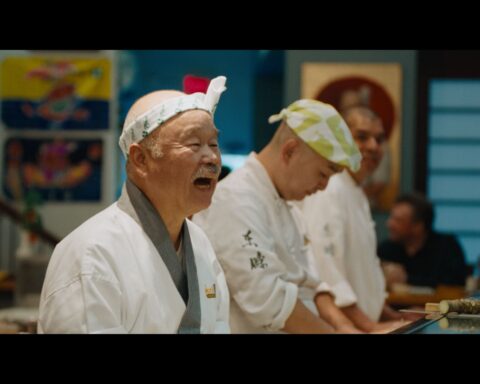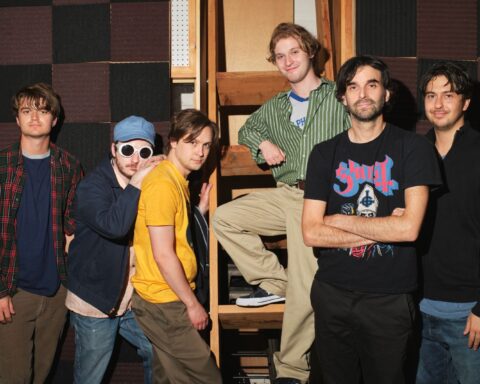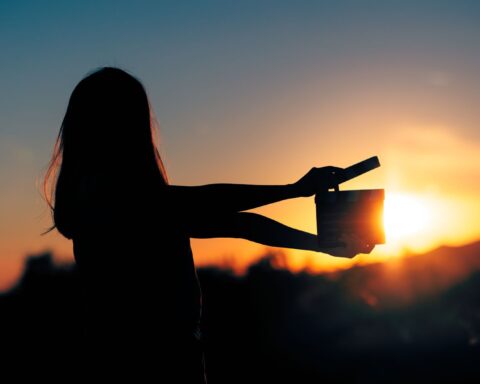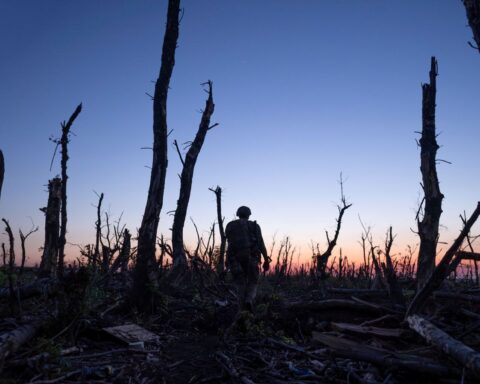Awards have been handed out and the VIFF Repeats announced: the 38th edition of the Vancouver International Film Festival (VIFF) has come to an end. While it started with the announcement of Jacqueline Dupuis stepping down as Executive Director, this edition also brought good news. The history of the festival is dotted with closing theatres and disappearing neighbourhood cinema. But the tables have now turned. The Greater Vancouver International Film Festival Society received federal funding ($1.4 million) for an architectural renovation, allowing them to add a multi-use atrium in the Film Centre. VIFF is literally expanding the frame. While the architects gather their troops, we’re taking a closer look at some of the festival’s documentaries that may or may not have performed the same expansion.
The Chinese documentary Present. Perfect. (dir. Shengze Zhu) opens with images of work sites, cranes and demolition. The quality of the image is relatively poor and evokes the webcams placed on top of mountains to monitor the weather. The main give-away is the live sound: road traffic webcams are usually silent. Humans are introduced by the fourth shot. When a farmer approaches the camera saying: “Wealthy people want to experience the farming life,” the initial ‘dance of machines’ has already completely transitioned into something else. The farmer, instead of working the land, sells an experience. We enter the peculiar world of Chinese live streaming platforms.
Divided into four chapters, Present. Perfect. is an impressive feat of research. The collected live feeds, all converted to black and white, become both poetic and relevant in their narrative conglomeration. Dismembered from each other, and in their original colours, the feeds wouldn’t be nearly as interesting. Or even particularly thrilling to watch. But, like Liza Mandelup in her documentary Jawline, Shengze Zhu finds beauty in the modern phenomenon of internet fandom, live feed communication and human interaction governed by screens. Between a young mother working in an underwear factory, an intersex person moving out of their parents’ house, a panhandling disabled person and a burn victim, we are still boldly treading a fine line between heartwarming curiosity and depressing cynicism.
Shengze Zhu, however, seems to avoid the trap of miserablism in Present. Perfect. as successfully as Heather Young does in Murmur. The first feature of the Nova Scotian filmmaker has been described as a hybrid between fiction and documentary. But it might be her formalist approach that feeds the most into her conveyed message of social isolation. She keeps her lens lingering on the swirling foam of a cleaning bucket and her frame tight on her sole character. In the total absence of a soundtrack, we observe a hand scratching the fur of a dead pet, its fingers disappearing in the long white dog hair. For a lonely addict, time passes rather slowly. The story is carried by Donna (Shan MacDonald), an older woman depicted as a broken and flawed but complete character. It had already won the FIPRESCI award and numerous accolades at TIFF, but Murmur went on to snatch up awards in both Calgary and Vancouver for director Heather Young as an Emerging Artist.
While Murmur’s focus is on one individual, the scope of My Window encompasses a whole country: Brazil. Its particularity is that experimental filmmaker Rodrigo John shot the whole documentary from his apartment window. Starting from an idea developed while recovering from an injured knee, he collects impressions of his neighbourhood over a period of ten years. Consolidated, they form his bittersweet account of Brazilian society.
Playing with his views of Porto Alegre’s high rises, the filmmaker observes his neighbours in the intimacy of their homes. They do what most people do: taking dance classes, cleaning windows, posing for selfies on rooftops, watching porn, renovating, etc. But John’s observations aren’t mundane. His camera witnesses civil unrest, menacing oil freighters, homelessness, endless construction and marching police forces.
Coupled with shreds of news broadcasts coming from the apartment and archival footage of pivotal moments of unrest, the film morphs into an examination of the political realignment of Brazilian society. Like Petra Costa’s The Edge of Democracy, John narrates the country’s wretched shift to the right, from Lula to Dilma Rousseff to Jair Bolsonaro. But his lens also pays attention to receding shadows as the days pass. By repeating the opening of blinds and the gurgling sounds of a moka pot, a daily rhythm is installed. My Window dwells long enough on the quotidian and the personal narratives of the people around John to let his melodious documentary grow into the symphony of a vibrant city.
Another pupil of Stan Brakhage’s lyrical cinema is Dan Popa. Drawing on both his Romanian and Quebecois background, he dives into a maritime adventure. Symphony in Aquamarine engulfs the audience meandering from boat to boat. Some might reject the idea that Murmur, My Window and Symphony in Aquamarine belong to the documentary department. It is true that they stretch the label to fit them in. The films uphold, each in their own way, the festival’s rallying cry: they expand the frame. The narrative and formal proprieties of the film medium are explored, shaped and moulded into the story they wanted to tell.
A film that hasn’t expanded anything is Haida Modern. Charles Wilkinson’s and Tina Schliessler’s latest puts the life and career of influential Indigenous artist Robert Davidson on the pedestal he deserves. Despite being neatly organized in generic chapters (Work, Family, …), the talking heads documentary honouring the artist and his contribution to the arts feels a bit scattered.
Haida Modern starts with the camera hovering around the Statue of Liberty. The symbol of freedom for the United States is a problematic opening for a tribute to someone who has had to challenge the persistent tentacles of political and cultural imperialism throughout his life and career. When Wilkinson emphasizes the importance and recognition of the Haida artist with an enumeration of sculptors like Rodin, Calder and Giacometti, the same dynamic perseveres. Wouldn’t a portrait of Robert Davidson have benefited from an attempt to decolonize the lens that zeroes in on his work? Using the western canon as the only prism through which his art can be appreciated echoes the mistakes that nearly eradicated the Haida.
The blanket imagery of the B-roll footage too often lacks the spiritual or even aesthetic sentiment it clearly aspires to deliver. The image of Davidson at New York’s Metropolitan Museum of Art forms the exception that captures the essence of the documentary. The artist sits on the steps of the museum, surrounded by other visitors. All absorbed by their phones: he’s the only one looking up observing the beauty we fail to see. The premiere of Haida Modern at VIFF was nevertheless met with a standing ovation, a testament to the success of the master carver and the Haida Renaissance he set in motion.
Two other documentaries were overwhelmed by the greatness and urgency of their own subjects: Coup 53 (dir. Taghi Amirani) and System K (dir. Renaud Barret). The Vancouver Playhouse was filled to the brim at the premiere of Coup 53. The Iranian community was represented en masse, judging by the collective sighs at the passages with ex-Minister of Foreign Affairs Ardeshir Zahedi. Playing a pivotal role in the Anglo-American coup of 1953 against the beloved prime minister in Iran, Mohammad Mossadegh, the 90-year-old former diplomat clearly isn’t well liked. Nor would MI6 agent Norman Darbyshire were he still alive.
Coup 53 gives an origin story to contemporary geopolitical dynamics and reveals the imperialistic tendencies of post-war, oil crazed Western countries. It is a pertinent film built around one document, the redacted transcript of a missing but revealing 1985 interview with Darbyshire – the spy who orchestrated Operation Ajax, which overthrew Mossadegh’s regime. With the help of editor Walter Murch and actor Ralph Fiennes, Amirani dissects, reenacts and highlights this vital piece of Iranian history. The result is a thriller-documentary, with Amirani as the detective, Fiennes as the spy and an unwavering feverish flow of information. One has to hold on to not lose the tread.
With System K, French filmmaker Renaud Barret continues his journey through the ingenious street arts of Kinshasa. Especially known for his music documentary Benda Bilili!, he seems to have a knack for finding the creative gems of the vibrant capital of the Congo. System K refers to the francophone idiom ‘système D’ for débrouille. In Kinshasa, you make do. You wing it. You DIY yourself out of the slump and onto the right track.
Barret starts his series of twelve portraits with Freddy Tsimba, whose sculptures made out of recycled materials have already gained him international fame. Tsimba is closely followed by a whole new generation of hungry and raging artists. Somewhere between pantomime and performance, Kongo Astronaut, Géraldine Tobe, Strombo and several other artists label their work as protest art. Using whatever they can find, they reassemble their recycled materials into costumes, paintings, sculptures and music instruments. Critiquing the current affairs in the Congo and the world, they interact with the crowds of the city for whom their eclecticism might, at times, be a little too avant-garde. Recording in the streets, the film’s open lens unapologetically invites friendly faces to peer in.
They all stand out, but the self-taught artist Béni Barras is particularly touching. In limbo between Belgium and Congo, the tragic figure hovers around his colleagues. An absent gaze indicates he’s high most of the time. But he’s clearheaded enough to stress both the importance of the art and the urgency of the issues that spark it. He’s roaming. The soundtrack roams as well, often exploring new places while the camera stills lingers somewhere else. Like Coup 53, the stream of information is constant and relentless. The immersive portrait leaves a lot to ponder over. It might be hard to digest, particularly for Canadian audiences that do not necessarily have the tools to contextualize specific issues, like the lack of access to resources (the conflict mineral Coltan, for instance), the political corruption or the impact of evangelical churches, addressed in the artists’ performances.
Shengze Zhu’s research for Present. Perfect. took ten months and 800 hours of footage while it took Taghi Amirani over ten years of archive rumbling to make Coup 53. But 63 Up takes the crown.
63 Up is the ninth instalment of a British TV series directed since the second episode by Michael Apted, that has followed a group of British citizens for six decades. Every seven years, Apted has sat down with eleven individuals for an in-depth conversation about their lives. While he poked around, they often found themselves confronted with their choices and the turn their lives had taken. Most of the participants get all choked up at some point during the interviews and British audiences, who grew up with this television landmark, won’t be able to hold back the occasional tear either. In 63 Up, a flood of archival footage and a few slightly outdated questions are mashed up within the most recent interviews.
While the original premise of the series remains: “Give me a child until he is seven and I will give you the man,” it also had the intention of measuring the evolution of the class division in Great Britain. If these two main inquiries remained as a red thread throughout the series, other questions shifted. Questions about boy-and-girlfriends at age fourteen naturally made way for health related questions at age 63. “You know me, Michael.” Apted seems to have become part of the family of the baby-boomers, most of which are now comfortably settling in for retirement. But 63 Up is also the first episode that needs to deal with participants passing and chats about of the transience of life are inevitable. And so are questions about Brexit.
While Dorothy Woodend recovers, most Vancouverites slowly return to their mountain-bikes, yoga-mats and hiking boots. The diehards, however, can continue exposing their eyeballs to the silver screen at this year’s VIFF Repeats, among which the excellent The Whale and the Raven will be screened. And, as long as filmmakers like Heather Young or Shengze Zhu keep expanding the frame, it’s never over.




